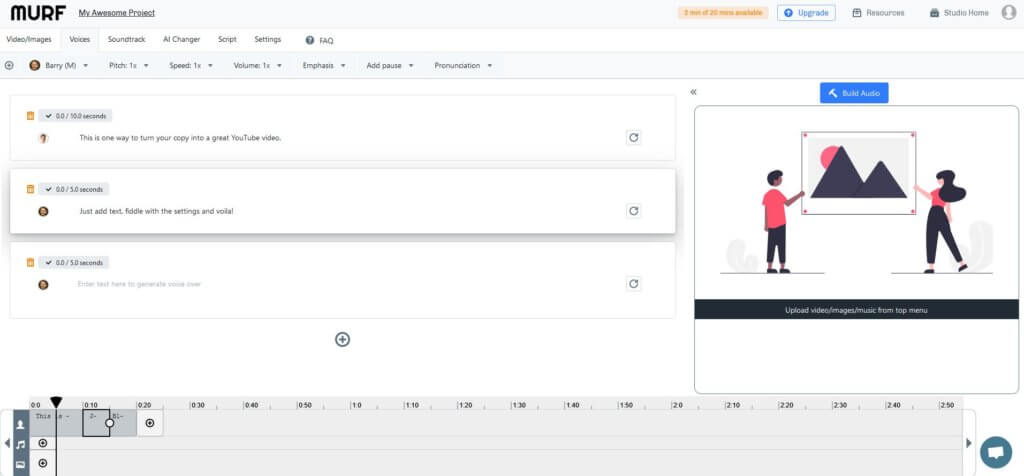Want some Grammarly alternatives or a better way to do content writing, creative writing or copywriting? We went through our stack of productivity tools and picked the best writing apps for 2021, with some AI writing software included to help you fill out larger projects:
- Hemingway
- Scrivener
- LivingWriter
- Plottr
- Campfire
- Ulysses
- ProWritingAid
- Dragon Anywhere
- Final Draft
- FocusWriter
- Reedsy Book Editor
- Manuskript
- Natural Reader
- EssayBot
- PepperTypeAI
- ConversionAI / Jarvis
- Freedom
The Best Writing Apps: Hemingway
Ernest Hemingway earned a silver Medal of Valor in Italy, accused of war crimes after leading armed troops despite being just a war correspondent, was allegedly a spy for the KGB and was involved in two airplane crashes in 2 days. Through all of this, he still had time to put out an impressive body of work. And he didn’t even have an essay help app like we do!
A tall order to compare yourself to Hemingway? Perhaps, but that shouldn’t stop you from boosting your own creative skills!
Hemingway’s legacy lives on in one of the best writing apps we used so far and we think it might help you too.
The Hemingway app will give you the tools to write fast, just like the legendary man itself, and has about as many features as Hemingway himself had jobs.
The Hemingway app overview on the official website is short and to the point, just like great writing in general.
“The app highlights lengthy, complex sentences and common errors; if you see a yellow sentence, shorten or split it. If you see a red highlight, your sentence is so dense and complicated that your readers will get lost trying to follow its meandering, splitting logic — try editing this sentence to remove the red.
You can utilize a shorter word in place of a purple one. Mouse over them for hints.
Adverbs and weakening phrases are helpfully shown in blue. Get rid of them and pick words with force, perhaps.”
Like Grammarly and other style checkers, it gives you Readability ratings for multiple elements of your writing. It will catch on if you use too many adverbs, abuse passive voice, write convoluted sentences or use “lots words when few do trick.”
The Hemingway app is just $20 upfront for the app download (no subscription required) and it is hands-down the most useful writing app we tried in this price range.
If you want a no-frills tool to improve your writing skills, whether you’re blogging or working on your thesis, give it a chance.
The Best Writing Apps: Scrivener
Scrivener is one of the oldest and best writing apps out there, offering a way to write large-scale pieces like a book or a thesis without losing track of your plan or outline.
Ever had to copy-paste a huge block of text of more that 2000 words in Google Docs or Word? Then you know how much of a hassle rearranging a big project can be, particularly if you hadn’t previously formatted it with headings.
With Scrivener, a writing app designed specifically for big projects, you can simply drag and drop that chapter into a new folder. All the chapters or parts of your project are neatly organized on the left-hand side in a “binder”, where you can also drop research, website clippings and more, dragging and dropping them into their correct location.
Check on the right side of the app and you’ll find The Inspector, our favorite feature to organize our work.
The Inspector lets you write a synopsis of what’s in the specific chapter or, if you’re in a hurry, can auto-detect and do it for you.
The Best Writing Apps: LivingWriter
LivingWriter is a great alternative to Scrivener, working pretty much the same way but with the added perk of being available in the browser.
If you were looking for a Google Docs alternative, LivingWriter is also a close match, with a similar layout that’s very intuitive and friendly to those just starting out with professional writing and editing apps.
However, the functionalities are a lot more advanced than regular word processors.
A handy tool for writers of fiction or other works with many characters is the “story elements”. Here you can add personal details about characters, map out their quirks, their relationships and even add pictures.
If you’re just starting out with writing larger works, LivingWriter also has some great plot templates to help you achieve a better structure.
For non-fiction, there are memoir, biography, self-help and book proposal templates. For non-fiction, you will find popular templates like Hero’s Journey, Dan Wells’ Seven-Point Story and the basic Three Act Structure, which can be applied to most plots or sub-plots.
The app also has a few gamification features to keep you motivated while writing, letting you set goals for chapters or number of words.
LivingWriter has a 2-week free trial to get started, then has a monthly subscription fee of around $10 (the price varies if you pay as you go or upfront for a year).
The Best Writing Apps: Plottr
Plottr is another writing app you can use to finally get started on your novel. It’s available for download on both Windows and Mac.
As its name says, this is more like outlining software rather than a regular writing app, but the suite has features to help you write both short and long-form content.
You also have plot templates here, from the essential Hero’s Journey to the 8 Sequences Method or basic romance or adventure novel writing.
The fun stuff begins if you are brave enough to start your own unique plot structure.
You have a timeline on which to arrange your chapters and you can easily keep track of the main plot and subplots, making sure your story has an engaging rhythm.
If you want to modify an act, simply drag and drop it in the place you need!
If character writing is the bigger challenge you need help with, Plottr can help you keep track of character traits and quirks, so that their personality is in the front of your eyes when you’re writing their actions. You can add just short character bios or you can include their Myers-Briggs personality, cognitive distortions and even Enneagrams.
The Plottr trial is a generous 30-day opportunity to try it out before spending for a license, which is available as a “one year” or a “lifetime” purchase. It also has a mobile app but we haven’t tried that one and existing reviews are overwhelmingly negative.
The Best Writing Apps: Campfire
Campfire the writing app (not to be confused with the productivity software that was bundled into the Basecamp suite) is yet another option to start world building for your next novel and keep track of every detail.
Still, don’t look at Campfire as a word processor because it isn’t one. Rather, this app is more like a project management tool designed for novelists, especially scifi and fantasy ones, to help keep them organized and on-track.
Campfire Pro is on Steam too but the price is a bit higher than other similar apps. Expect to pay around $50 for the base software and another $20 or so for the DLC with worldbuilding tools.
Campfire Blaze, the evolution of it, is in a beta program that gets bi-monthly updates.
You can join it here and take advantage of the flexible pricing options, paying only for the features you need and use often.
The Best Writing Apps: Ulysses
If you’re in the Apple ecosystem, the best writing app for you might be Ulysses. This minimalist app reduces clutter almost completely, just like Hemingway for Windows.
Ulysses is great on a MacBook or on an iPad with an added keyboard but, in a pinch, it works just as well on the iPhone’s smaller screen, with no need for keyboard attachments.
For an old-school, distraction-free writing project, switch to the typewriter mode. For late-night crunches before a deadline, Ulysses’ dark mode will keep your eyes rested.
It supports larger writing projects, with nesting groups to organize chapters. It can even help you compile your ebook for self-publishing, with a live preview to show you exactly how the final export will look.
Since it supports markups and has attachments for notes or PDFs, if you’re creating a SEO article you can include keywords and other resources for future edits.
The Best Writing Apps: ProWritingAid
If you’re already familiar with Grammarly and its proofreading capabilities, then ProWritingAid is the upgrade you should be looking for.
It doesn’t have a design as sleek but it’s still browser based and the functionality is a lot more extended. It goes beyond basic grammar checking and offers a good style editor. You can find word replacements to avoid repetitions or find stronger verbs, simplify phrasings for better readability, and even avoid cliches and redundancies.
The best part is that ProWritingAid doesn’t force you to use it alone.
Instead, it has integrations with Google Docs, Microsoft Word and even Scrivener, so you can easily import, export and work on your piece from anywhere.
If you write short work under 500 words, like small blog posts or news updates, the free version of ProWritingAid is a good tool to ensure quality.
If you’re looking for a writing app to help with longer content, you’ll need the paid ProWritingAid. It’s available either as pay-as-you-go for $20 per month, which is somewhat on the expensive side compared to the previous apps we talked about, or as a yearly, around $80 subscription.
The Best Writing Apps: Dragon Anywhere
This next writing app is a bit different from the pack – it focuses on speech, not editing.
Dragon Anywhere is a good text-to-speech reader which will help you fine-tune your dialogue and sentence structure. If you write video scripts or work in TV, Dragon Anywhere can help make the scripts you write for your hosts a lot more organic, organized and easy to pronounce.
If you have an unusual accent or pronunciation, you can use the Train Words feature to help the software understand you better.
We also found it a very good way to proofread while working around the house. Just use text-to-speech while away from the desk and come back to work and edit whenever you hear a spelling mistake.
Indeed, the actual writing components of this app are somewhat rudimentary. You can edit and delete text but it’s little more than a note-taking app in this regard.
Dragon Anywhere works best if you just use it as a dictation app and import the text into another editing app for final formatting.
The Best Writing Apps: Final Draft
Final Draft is another niche writing app, one designed exclusively for scriptwriters.
We love combining Dragon Anywhere with Final Draft whenever we have to do scripts for web shows and commercials, since this combo helps you write the most believable, natural dialogue. You dictate lines into Dragon Anywhere (and speaking them out loud does help you get a better flow and account for diction traps!), then import the notes into Final Draft for easy formatting into a well-structured script.
It will automatically compile a list of characters and scene locations, letting you insert them fast, without breaking your focus on dialogue.
To help you pace the story better, it has a Story Map and also features a Beat Board for arranging scenes.
However, Final Draft is one of the more expensive writing apps for iOS and Windows, so this is a professional tool. The writing app for iOS goes for just $10 but the iOS and Mac versions cost $249. Fortunately, they have a generous 60 day trial, so you can really put Final Draft to the test.
If you can’t justify the cost read on – we have some great (and free!) writing apps for Windows, Mac, browsers and everything in between.
Free Writing Apps: FocusWriter
FocusWriter is a totally free writing app with most of the features you need to focus on your work.
It has a hide-away interface that you access by moving your mouse to the edges of the screen, timers, alarms, daily goals, lots of customizable themes for inspiration or reducing eyestrain and even multi-document support.
While the interface itself is kind of dated, the features work just as great as most of the paid writing apps we tried.
FocusWriter is open-source software available on Windows and most Linux variants. If you like it, consider donating to the developers to support them in releasing more features.
Free Writing Apps: Reedsy Book Editor
Ready to start e-publishing your novel? For new writers, keeping costs down is essential, so, for this, we recommend giving Reedsy Book Editor a spin.
This great free tool is not just a fantastic writing app to proofread and structure your book. It also lets you typeset like a professional and exports the book in publishing-ready PDF and ebook formats.
Just take a look at this demo and see for yourself!
Free Writing Apps: Manuskript
Then, there’s Manuskript, one of our favorite open-source writing apps. It comes with all the formatting options you expect but also has plenty of tools to organize your work by chapters or scenes. The “story line” is basically a timeline where you can arrange your plot and work on story pacing.
Manuskript is a perfect tool for those writers who like to organize and plan everything before writing.
The snowflake method can help you grow your idea into a book, by leading you step by step and asking you questions to go deeper.
“While writing, keep track of notes about every character, plot, event, place in your story,” say the developers.
It’s also a great Linux alternative to Scrivener, so, if you use that operating system, download Manuskript and get writing! Since this is open-source software, also please consider donating if this tool was helpful to you.
Free Writing Apps: Natural Reader
Do you read your work out loud often? Any great writer does this at least once after completing a draft, to see how the text flows, find disjointed sentences and fix dialogue.
To avoid our personal biases and frankly somewhat terrible diction, we love using the NaturalReader app to read our writing out loud.
Natural Reader is pretty much the gold standard for AI voices. It has fantastic natural voices with various English accents, works on both Windows and Mac and accepts most document formats.
The free Natural Reader version has unlimited documents you can upload and has a Pronunciation Editor that lets you tweak nuances. There’s even a free widget that works on most websites and a browser-based version, so you can use it anywhere.
Natural Reader is also available with a one-time payment for a perpetual license, a rarity nowadays when it comes to software, and retails for $99.
Apps to Help Writing: Murf.AI
Another fantastic option for AI voices is Murf.AI, a subscription-based software with hundreds of options and a very impressive editor to boot.
The Murf.ai is an AI voice generator that can turn your copy into an incredibly lifelike voice-over – no one would be able to tell it’s a bot, not a person reading the script.
It has templates for trailers, explainer videos, app walkthroughs and more.
In the studio you simply paste your text or upload a document, then pick your favorite voice, the pitch, add emphasis where you want it and edit everything in real time.

The basic free Murf.ai account lets you try more than 100 voices to generate up to 10 minutes of voice-overs or transcriptions, then gives you a link to share your work with others.
The paid plans start at $13 per month and offer unlimited downloads, commercial usage rights and access to 60 voices in 10 languages. Pretty nifty, right?
AI Writing Apps
You know how it is: sometimes you really need to find a way to boost your creative output, especially when you have a big project to turn in and a very tight deadline.
For SEO content pieces or short and actionable social media copy, AI writing apps can help you deliver more, in faster times.
Artificial intelligence-written content won’t replace actual live writers and can’t match their creativity but it does have its place in a writer’s arsenal.
For rephrasing, short news or longer SEO-optimized content pieces, there are a few AI Writing Apps that can save you some time to focus on more creative projects.
The Best AI Writing Apps: EssayBot
You know how it is: sometimes you just have to churn out some content.
For particularly boring, stuffer-type pieces, we tried EssayBot a few times and found this AI writing assistant very helpful.
Just give EssayBot a title, and it will help you find sources, help you paraphrase content and even include citations.
Our favorite part is definitely the prewritten first paragraph that EssayBot spits out as soon as you give it just a title.
We never actually went with it, and not just because it can be word-salad, but it did wonders to smash through our writer’s block. Once you see how EssayBot suggests you start your piece, you won’t be able to help yourself and will try to create something better!
The Best AI Writing Apps: PepperTypeAI
PepperType.AI works the same way but for the shorter pieces of content needed in your marketing campaigns.
Just in how many ways can you spin a message like “Buy Now”? Fortunately, PepperTypeAI has a lot of variations and can help you churn out ad copy quickly.
If you’re sick of writing for banners, social media ads on Google or Facebook or YouTube descriptions for webinars, give it a spin.
The Best AI Writing Apps: ConversionAI / Jarvis
Formerly known as ConversionAI, Jarvis is one of the better AI content generators we tried. It works just like the previous tool we recommended and spits out incredible ad copy variations.
You can take the easy route and let it create your marketing plan for the quarter, or you can use it to find inspiration whenever you’re too tired to write effective call-to-actions and social media copy.
When you’re struggling to hit word counts, Jarvis can also help with a sentence expander.
And lastly, we have an invaluable app to help you write better, for longer.
Do you tend to do research before writing a story but invariably end up on a random Wikipedia rabbit hole or procrastinating on social media?
The Best Writing Apps: Freedom
Then you need Freedom, probably the best writing app to eliminate distractions.
Freedom blocks any and all online distractions, from social media to games and even Wiki sites (for those prone to get lost in reading unrelated tidbits).
You have a simple interface to pick all the apps and websites you want to avoid when concentrating on your work.
The app works across devices on any OS, from Windows to Mac or Android. It lets you start sessions when you want, which is great for when you have a sudden request and a tight deadline, or lets you plan out sessions in advance, for when you’re trying to organize your workflow better.
The best part? It’s one of the cheapest productivity tools we’ve come across, at less than $2.50 per month.
Did we miss a good writing app or an AI writing tool? Drop us a line and we’ll try it and update this article accordingly.
Follow TechTheLead on Google News to get the news first.



















